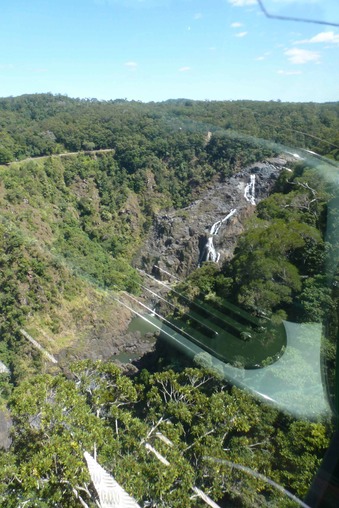Madam had left strict instructions to look out for the distinctive electric blue of the Ulysses butterfly, something that didn’t seem of great import to The Niece, until she spotted one, and it wasn’t too long before The Sister was in on the butterfly spotting act.
As is almost invariably the case in such circumstances, Hughesy’s side of the gondola seemed totally butterfly free, but I consoled myself with the thought of crocodile spotting a little further on and enjoyed the quite magnificent treetop view.

Red Peak is all about the rainforest itself, and while that’s still a significant element at the second stop at Barron Falls the focus is on the Gorge carved by the river. You get spectacular views of the chasm on the run in to the Barron Falls Station, and once you’ve alighted you might as well take a stroll around the walkways and lookouts, particularly if you’re not taking the train back to Cairns.
You can’t see the Falls from the highway, and while they’re not as spectacular as they could be if the river wasn’t dammed they’re still reasonably impressive. They’d be quite a sight in the middle of a good Wet season, but the middle of a good Wet would bring its own issues with precipitation and visibility.
The Barron Falls stop also features a fair deal about the hydroelectric scheme that dates back to 1935, when the Governor of Queensland opened Queensland's first hydroelectric power station. A project of this type had been mooted as early as 1906, though there were the predictable issues with access to the site, what with the gorge, its precipitous cliffs, the wet season’s torrential rain, and the floods that would inevitably ensue from the runoff from Queensland’s wettest section of coastline.
The Barron’s not the only river that carries the runoff, but it’s the only one draining the northern part of the Atherton Tablelands that flows to the Coral Sea. Materials and machinery used in the construction of the project came up the railway line, which had been operating since 1891.
The line got things as far as a rail siding, but with the construction happening on the other side of the river everything needed to be transferred over the falls by flying fox and lowered by tramway to the worksite. There are examples of both beside the walk way back from the three lookouts above the Falls.
The original power plant was dismantled and decommissioned in 1959 with a new power station constructed further down stream, coming onto the grid in 1963.
Having taken in the views of the Gorge and Falls we headed back for a look at the Rainforest Interpretation Centre, developed in conjunction with CSIRO, which is definitely worth a look if you’re after a visual and interactive explanation of what you’ve been looking at from above.
There’s also a Djabugay Aboriginal Guided Tour at Barron Falls Station which takes about forty minutes and gives the visitor some idea of the local rainforest people’s history, language, culture and traditions. WE didn’t opt for this one this time around, but, on a future visit I’m definitely planning to.